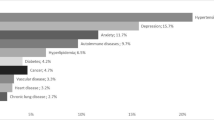Abstract
This cost-of-illness analysis for the United Kingdom is part of a Europe-wide study on the costs of multiple sclerosis (MS). The objective was to analyze the costs and quality of life (utility) related to the level of disease severity. People with MS from a database administered by a UK charity (the MS Trust) were asked to participate in the survey by answering a postal questionnaire. In addition to details on the disease (type of disease, relapses, level of functional disability), the questionnaire asked for information on all resource consumption, medical, non-medical, work absence and informal care as well as utility. The response rate was 19%, and a total of 2048 people were included. The mean age of the cohort was 51 years, and 23% of people were ≥60 years of age. Disease severity was concentrated in people with moderately severe MS (Expanded Disability Status Scale [EDSS] score of 4 to 6.5), with 21, 60 and 19% of people reporting mild, moderate and severe disease, respectively. Costs and utility are highly correlated with disease severity. Mean annual costs for all people in the study increase from approximately £ 12.000 at an EDSS score <4 to almost £ 60.000 at an EDSS score ≥7. In particular, employment rates are reduced from 82% in early disease to 2% at an EDSS score of 8, while the costs of inpatient care, investments, informal care and productivity losses increase by more than tenfold between an EDSS score of 0-1 and a score ≥7. Utility decreases from 0.92 at an EDSS score of 0 to a state worse than death in the most severe state (–0.18 at an EDSS score of 9). Compared to the results in an earlier cost study in the United Kingdom using a comparable methodology, costs have substantially increased, by roughly 40%. Part of the increase is due to a higher use of disease-modifying drugs and, possibly linked with this, a higher use of ambulatory care and services. Another part of the increase is most likely due to an increased age in the current sample, with more patients on early retirement due to MS and more intense use of informal care. However, another reason may lie in the methodology, e.g. different unit costs or differences in the sample distribution, despite a similar mean EDSS score of 5.1.






Similar content being viewed by others
References
Pugliatti M, Rosati R, Carton H et al. (2006) The prevalence and incidence of multiple sclerosis in Europe. Eur J Neurol 13: 1–23
Richards R, Sampson F, Beard S, Tappenden P (2002) A review of the natural history and epidemiology of multiple sclerosis: implications for resource allocation and health economic models. Health Technol Assess 6: 1–73
Kobelt G, Lindgren P, Parkin D, Jönsson B (2000) Costs and quality of life in multiple sclerosis. A cross-sectional observational study in the United Kingdom. SEE/EFI Working Paper Series in Economics and Finance No. 399. Stockholm School of Economics; Stockholm, Sweden
Swingler R, Compston D (1992) The morbidity of multiple sclerosis. Q J Med 83: 325–337
Mcdonnell G, Hawkins S (2001) An assessment of the spectrum of disability and handicap in multiple sclerosis: a population based study. Mult Scler 7: 111–117
O’Brien B (1987) Multiple sclerosis. Office of Health Economics, London, UK
Kobelt G (2004) Economic evidence in multiple sclerosis: a review. Eur J Health Econ 5: 54–62
The EuroQol Group (1990) EuroQol – a new facility for the measurement of health-related quality of life. Health Policy 16: 199–208
Dolan P, Gudex C, Kind P, Williams A (1995) A social tariff for EuroQol: results from a UK general population survey. Discussion Paper 138 (York, Centre for Health Economics, University of York)
Holmes J, Madgwick T, Bates D (1995) The cost of multiple sclerosis. Br J Med Econ 8: 181–193
Blumhardt L, Wood C (1996) The economics of multiple sclerosis: a cost of illness study. Brit J Med Econ 8: 99–118
Murphy N, Confavreux C, Haas J et al. (1998) Quality of life in multiple sclerosis in France, Germany, and the United Kingdom. Cost of Multiple Sclerosis Study Group. J Neurol Neurosurg Psychiatry 65: 460–466
Acknowledgement
U. Lilja (Stockholm Health Economics, Stockholm, Sweden)
Conflict of interest
No information supplied.
Author information
Authors and Affiliations
Corresponding author
Rights and permissions
About this article
Cite this article
Kobelt, G., Berg, J., Lindgren , P. et al. Costs and quality of life of multiple sclerosis in the United Kingdom. Eur J Health Econ 7 (Suppl 2), 96–104 (2006). https://doi.org/10.1007/s10198-006-0380-z
Issue Date:
DOI: https://doi.org/10.1007/s10198-006-0380-z




